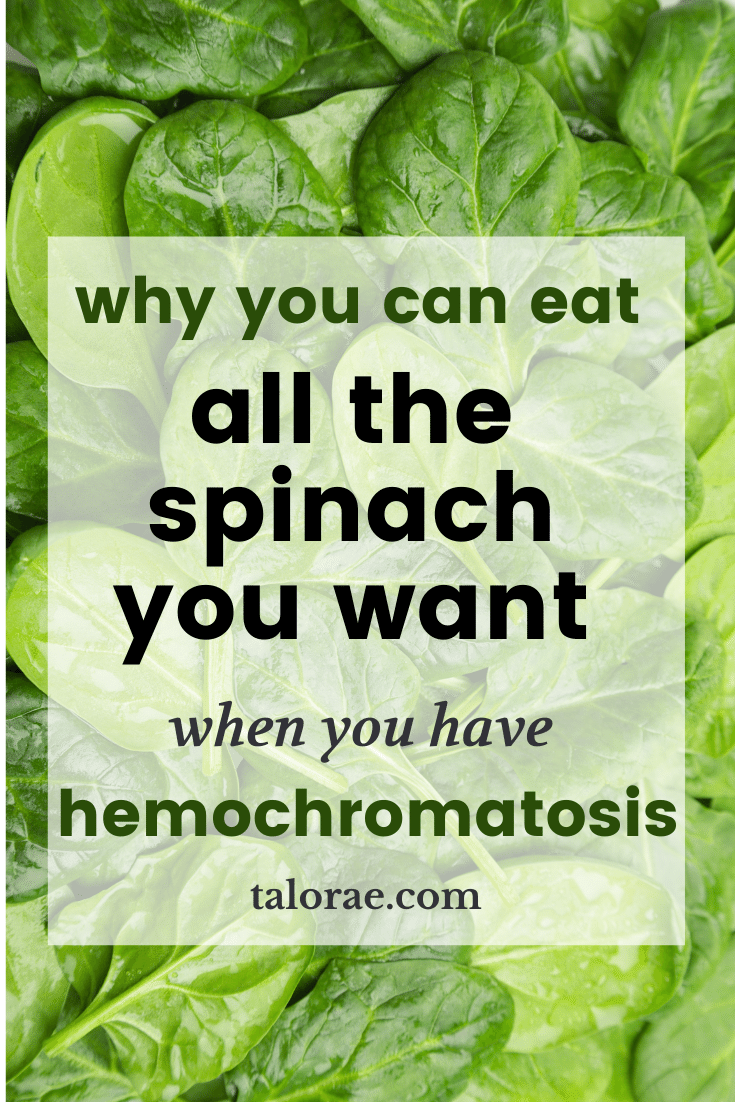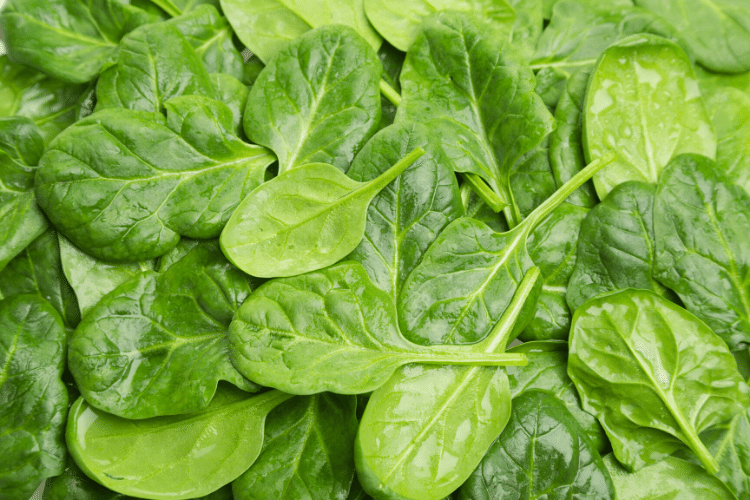Heads up! I’m NOT a doctor or nutritionist. I’m not giving you any medical advice or dietary recommendations here. Check with your doctor before you make any changes to your lifestyle, diet, or supplement regimen.
Try this easy experiment: Go ask anybody you know what they’d suggest eating for someone who wants more iron in their diet.
I can pretty much guarantee that one of the foods they’ll list is “spinach.”
In fact, I can’t tell you how many times people have said to me, “So you can’t eat any spinach?” when I tell them I have iron overload because it has “so much iron.“
But the truth is this: when it comes to spinach, you’ve been lied to. Or at least, you haven’t been given all the facts.
Visualize this: An entire plate of raw spinach – 2 whole cups’ worth.
While spinach does contain more iron than many other vegetables, for a heaping plate of the stuff it’s not as much iron as you might think.
That plate of spinach contains…
- 1.6mg iron in 2 cups raw spinach
Weigh that against…
- 5.6mg iron in one 8-ounce steak
- 6.9mg iron in three medium-sized oysters
- 10.9mg iron in one cup of Frosted Flakes
Spinach is undoubtedly a source of iron, but it’s not exploding with it.
Now here’s where it gets interesting: the amount of iron in food doesn’t matter as much as how much iron your body actually takes in. Spinach contains iron, but it’s almost impossible to absorb it.
Studies show that when the average person eats raw spinach, they’ll absorb around 2% of the iron in the spinach, give or take. Some estimates are as little as .025% and some are as high as 7%. Someone with hemochromatosis will absorb up to 4x more iron than an average person – absorbing .128 mg iron from 2 cups of spinach.
Here’s a fun comparison: If the average person eats a piece of meat, they’ll absorb 20% of the iron in the meat, give or take. Some estimates are as low as 15%, some are as high as 35%. Someone with hemochromatosis will absorb up to 4x more iron than an average person – totaling 4.48 mg iron from the steak.
So a person with hemochromatosis can eat an entire plate of raw spinach and absorb .128 mg iron. That same person can eat a steak and absorb 4.48 mg iron.
That’s a big difference.
In fact, because of the minimal iron you’ll absorb, spinach is actually recommended by doctors and organizations if you have iron overload. Spinach is approved for the hemochromatosis diet in:
1. The Iron Disorders Institute’s Diet Recommendations for Hemochromatosis
2. Sanford Medical Center’s Nutrition Support of Hemochromatosis Therapy
3. The Haemochromatosis Society’s Healthy Eating and Haemochromatosis
Are you surprised? I’ll explain how it works, but first a bit of spinach trivia!
SPINACH TRIVIA: POPEYE – WE GOT IT ALL WRONG
Spinach is one of the most nutrient-dense green veggies in the world, and it’s especially high in vitamin K, vitamin A, manganese, and folate. While spinach is also a source of iron, it’s much higher in these other vitamins.
In fact, the reason the cartoonist E.C. Segar made his famous character Popeye eat spinach is because of its high vitamin A content; Popeye’s spinach eating habit had absolutely nothing to do with iron.

Due to some bad research and misinformed marketing back in the day – most of us still wrongly think of high iron as the reason why Popeye is so strong. His super-human biceps actually come from vitamin A, which spinach is a much better source of than iron.
Now I’ll shed light onto why spinach is a surprisingly great component of the hemochromatosis diet…let’s go!
HEME VS. NON-HEME IRON
Spinach contains only non-heme iron. Non-heme iron is not absorbed well into the gut. Your gut is able to regulate your absorption of non-heme iron much better than heme iron. Your intestines recognize when they’ve had enough iron from spinach, so they let the rest of the iron pass through your body. Non-heme iron (found in plants) is taken in by people with hemochromatosis at a 20-30% absorption rate, on average. That means you WON’T absorb 70-80% of the iron when you eat spinach or other plants! This is a big benefit for anyone with hemochromatosis.

Heme iron (found in meat) is taken in by people with hemochromatosis at an 80-100% absorption rate, MUCH higher than the rate for non-heme iron. That’s because the body has a much harder time regulating its uptake of heme iron.

POLYPHENOLS
Spinach contains a chemical compound that lowers iron absorption even more – THE POLYPHENOL.
You get polyphenols from plant-based foods. Spinach (with 119 mg polyphenols per 100 grams spinach) is considered to be one of the veggies richest in polyphenols, coming in third place behind artichokes (260 mg) and red onions (168 mg).
Polyphenols are a hemochromatosis patient’s BEST FRIEND because they do a wonderful job of blocking iron. They’re a big part of the equation explaining why you absorb so little iron when you eat spinach – polyphenols bind with the non-iron in the spinach, making the iron impossible for your intestines to absorb. One study noted that eating polyphenol-rich foods on a regular basis may even decrease the body’s iron storage levels.

The polyphenols in spinach also promote well-being and reduce inflammation – they’re powerful antioxidants that lower oxidative stress in the body and “benefit the body by fighting against harmful agents like ultraviolet rays, radiation, and some pathogens. Research has shown that diets high in foods rich in polyphenols can even help prevent the development of illness such as cancers, heart diseases, and diabetes,” according to dietician Meg Hagar, MS, RD.
Cancer, heart disease, and diabetes are all diseases that can be caused by hemochromatosis – which is another reason why the polyphenols in spinach (and other plant-based foods) are so important.
FIBER
Did you know that most Americans only eat 15 grams of fiber every day – half of the daily recommended fiber intake? Like almost all vegetables, spinach provides us with a significant amount of fiber. One serving – or 2 cups of raw spinach – provides around 1.4 grams.
Fiber is another important nutrient in the hemochromatosis diet because of its relationship with iron. While the extent to which fiber blocks iron varies based on the person, gender, age, and other factors – studies show that fiber lowers your iron absorption from food by a small amount, and specifically inhibits non-heme iron absorption (reminder: spinach and all other plants contain non-heme iron).
While fiber can’t block as much iron as polyphenols – every little bit counts!
That’s why the Iron Disorders Institute recommends eating foods containing fiber if you have hemochromatosis. High-fiber foods are plant-based foods like spinach, as well as other veggies, fruits, whole grains, and beans.
On top of its iron-blocking qualities – fiber eases your digestion and helps you eliminate toxins. And, similar to polyphenols, it protects against diseases that often show up as a result of hemochromatosis: specifically heart disease and diabetes.

SPINACH MYTH TO DEBUNK: OXALATES
You now know that there are 3 big reasons why you don’t absorb iron from spinach:
- Non-heme iron: spinach is made of non-heme iron, which is harder for the body absorb than heme iron.
- Polyphenols: spinach is high in polyphenols, plant chemicals that bind to iron and prevent the body from absorbing it.
- Fiber: spinach contains a significant amount of fiber, which helps to inhibit iron absorption.
What about oxalates? If you do your research on hemochromatosis, you may see some articles discussing oxalates in spinach and other foods. A lot of hemochromatosis websites today still reference oxalates. While their information is dated, it’s good to know what all these people and resources are talking about, so I’ll give you a quick explanation.
Oxalates are naturally-occurring food chemicals commonly found in fruits, vegetables, nuts and seeds, grains, and even tea.
For a long time, doctors and nutritionists believed that oxalates were the main reason why spinach blocks iron.
In fact, researchers attributed all of spinach’s iron-blocking qualities to oxalates. Oxalates were thought to suppress iron absorption by combining with iron to form a compound called iron oxide – our intestines cannot absorb iron oxide.
They’ve now realized that they were wrong.
While spinach is high in oxalates, recent research shows that those oxalates probably don’t play as important a role in blocking iron as we once thought.
Scientists now understand that polyphenols are the big reason why you absorb next to no iron.
What does this mean for you? Instead of seeking out foods with oxalates to keep your block iron absorption, you’ll want to look plant-based foods containing non-heme iron only, high-polyphenol foods, and high-fiber foods.
 Here’s an easy-to-understand graphic of how polyphenols (not oxalates) block iron, from CompoundChem.com!
Here’s an easy-to-understand graphic of how polyphenols (not oxalates) block iron, from CompoundChem.com!
HOW TO EAT SPINACH IF YOU HAVE HEMOCHROMATOSIS
RULE 1: EAT IT RAW
Eating spinach raw is the best way to keep your iron absorption from spinach extremely low.
Right now, conventional wisdom says that when you cook spinach, you break down the polyphenols, making iron in the spinach more bio-available.
For example, in one study, researchers blanched different vegetables for 1 minute in boiling water, including spinach. All vegetables lost 12-26% of their total polyphenols.

Personally, I’m not so sure. Another study compared different cooking methods on spinach, and cooking actually slightly increased the phenolic and antioxidant activity of spinach. And while it is true that cooking lowers oxalates (mostly cooking in water, such as boiling or steaming), we’re now aware that oxalates don’t do much in terms of blocking iron absorption from spinach, so that shouldn’t really matter, right?
But at the end of the day, I’m not a doctor or scientist. So at this point, I’m sticking with what the “big wigs” are saying, which is this:
Cooked spinach = more iron, Raw spinach = less iron
RULE 2: AVOID IRON-ENHANCERS
I’m MUCH more confident about this rule. There’s lots of research to back it up.
There are certain foods you’ll want to avoid combining with spinach if you need to minimize iron absorption.
Here’s a list of iron-enhancing foods. All of the below foods make your intestines absorb more iron from your food. To keep your iron absorption low when you eat your next spinach salad, avoid eating these at the same meal.
-
- vitamin C (lemons, oranges, etc.)
- acids (like vinegar and soy sauce)
- fermented foods (like sauerkraut or kimchi)
- carotenoids (sweet potatoes, carrots, red pepper, etc.)
- fructose and sorbitol (found in sugar and some other sweeteners)
- meat and fish
- alcohol

SUMMARY & FINAL THOUGHTS
How much iron a food contains matters less than how well that iron is absorbed.
Because spinach is made of only non-heme iron, is high in polyphenols, and provides a good dose of fiber, the iron it contains is NOT well absorbed into the body.
There are certain rules to keep your iron absorption from spinach low:
- Eat spinach raw
- Avoid pairing spinach with iron-enhancing foods
If you eat spinach raw and avoid iron-enhancers, you’ll absorb almost no iron, which is why spinach a great addition to the hemochromatosis diet and explains why this green veggie is actually recommended by many hemochromatosis doctors and organizations.
Is it the end of the world if you end up eating cooked spinach, or if you eat an iron-enhancing food (like a red pepper or some orange slices) with your spinach salad?
No.
Just know that you’ll be absorbing more iron, and factor that into your daily iron intake. You can also fight the iron-enhancing effect by drinking coffee or black tea, or taking a milk thistle supplement when you eat your meal.
Regardless, if you end up “unlocking” more iron because you cooked your spinach or paired it with an iron-enhancer, don’t stress.
You get phlebotomies for this very reason – to remove excess iron you’ve accumulated from your food.
As a reminder, we all NEED a little bit of iron to survive. Iron is what brings oxygen to our organs – without it they’d shut down. Don’t starve your body of the nutrients from a superfood like spinach because you’re so paranoid about avoiding iron.
And you know what?!
That 1.6mg of iron from a big ol’ plate of spinach is still a heck of a lot less than what you’d get from a steak, or a couple of oysters, or a bowl of Frosted Flakes.
So go ahead and eat your greens!

The views expressed in this post are for informational purposes only. This post is not, nor is it intended to be, a substitute for professional, medical, or nutritional advice, diagnosis, or treatment, and should never be relied upon for professional, medical or nutritional advice, diagnosis, or treatment.
No content on talorae.com, including but not limited to pictures, graphics, videos, and text, may be republished or distributed, for financial gain or not, without my written permission.
As an Amazon Associate I earn from qualifying purchases. The above content may contain affiliate links, meaning I do get a commission when you make a purchase through those links. There is no additional cost to you. Please read my disclaimer for more info.


